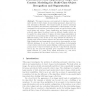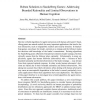814 search results - page 111 / 163 » Face Recognition Algorithms as Models of Human Face Processi... |
ATAL
2009
Springer
2009
Springer
Effective solutions for real-world Stackelberg games: when agents must deal with human uncertainties
15 years 4 months ago
How do we build multiagent algorithms for agent interactions with human adversaries? Stackelberg games are natural models for many important applications that involve human intera...
ICRA
2009
IEEE
15 years 4 months ago
2009
IEEE
— In this paper we present a novel methodology for detection and tracking of facial features like eyes, nose and mouth in image sequences. The proposed methodology is intended to...
IJCNN
2007
IEEE
15 years 4 months ago
2007
IEEE
Learning by human tutelage means that a human being guides the attention of a robot or agent in order to teach it a given concept. This kind of learning is very important to devel...
114
click to vote
ECCV
2006
Springer
16 years 13 hour ago
2006
Springer
Abstract. This paper proposes a new approach to learning a discriminative model of object classes, incorporating appearance, shape and context information efficiently. The learned ...
AI
2010
Springer
14 years 6 months ago
2010
Springer
How do we build algorithms for agent interactions with human adversaries? Stackelberg games are natural models for many important applications that involve human interaction, such...


